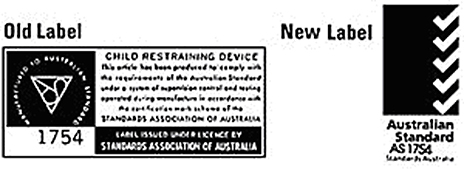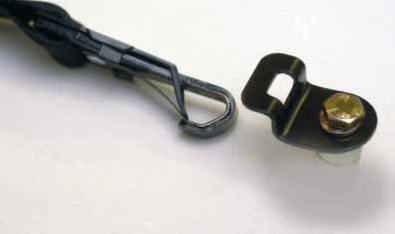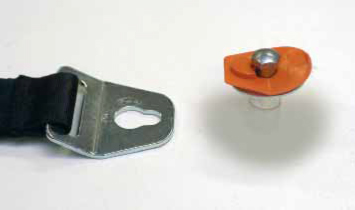Introduction
When travelling in a vehicle a child must be properly restrained to reduce the chance of serious injury or death if involved in a car crash.
A child restraint will protect your child from being ejected from the vehicle. It will also move the force of a crash to the strongest parts of a child's body.
All children under seven must be secured in an approved child restraint or booster seat when travelling in a car or vehicle in the Northern Territory.
You must also properly install a child restraint.
If you don't make sure your child is properly restrained you could face penalties.
Approved child restraints
The following table shows the types of restraint your child will need, sorted by age group:
| Age of child | Use this restraint |
|---|---|
| Under six months | Rear facing restraint - eg. baby capsule. This must not be in the front seat of a vehicle with two or more rows of seats. |
| Six months to under four years | Rear-facing or forward-facing restraint. This must not be in the front row of a vehicle with two or more rows of seats. |
| Four years to under seven years | Forward-facing restraint or booster seat. This can only sit in the front seat of a vehicle with two or more rows when all other seats are occupied by younger children in an approved child restraint. |
| Over seven years | Adult seatbelt or a booster seat |
If your child is too small for a restraint, keep them in the previous level of restraint for as long as needed.
If your child is too large for the restraint, they may move to the next level.
Your child is too large for a restraint when:
- the harness straps are below the shoulders, or their shoulders no longer fit if they are under six months old
- their shoulders no longer fit comfortably and their eye level is higher than the back of the seat if they're up to four years old.
For more information, read the national child restraint best practice guidelines on the Neuroscience Research Australia website.
Buying a new child restraint
Child restraints sold in Australia must meet the strict requirements of Australian Standard AS 1754.
Look for these labels:

Used restraints
If you plan to use a second-hand child restraint check:
- it has the Standards Australia mark
- it is not more than 10 years old
- it has not been used in a crash or is damaged
- the straps don't show any signs of wear or damage
- the plastic shell and the buckle are not broken, cracked or split
- the buckle and the adjusters work correctly
- you can lock and unlock the buckle
- the adjuster grabs the webbing.
You must get instructions that show you how to install the restraint. If you need help, contact an authorised vehicle inspector or Kidsafe NT.
Install a child restraint
You must use the manufacturer's instructions when installing a child restraint so that your child is safe.
If you need help, contact an authorised vehicle inspector or Kidsafe NT.
Safety tips for installing a child restraint
Always follow the manufacturer's instructions.
Place the restraint in the right location and direction for your child's age.
Make sure the tether straps are securely anchored to the vehicle and pulled tight without twisting.
Adjust the harness to fit your child's body comfortably yet firmly.
Never use an infant restraint in the front passenger seat if your car has a front passenger airbag.
Never place a child restraint on a vehicle seat that faces rearward or sideways.
Anchorage points for child restraints
All infant restraints, child seats and child harnesses must have the tether strap attached to your vehicle's anchor fitting.
Refer to your car manual to find the anchor fitting. It can also be known as an anchor bolt or an anchor point.
All passenger vehicles fitted with forward-facing rear seats manufactured on or after the dates listed below will have child restraint anchorage points:
- sedans - July 1976
- station wagons and hatchbacks - January 1977
- light passenger vans (up to 12 seats) - January 1986
- four-wheel drive vehicles - July 1990.
Generally, sports cars, utes, panel vans and vehicles fitted with side-facing rear seats do not have child restraint anchorage points.
New child restraints
Most new child restraints have a tether-strap fitting that looks like a hook. The hook-shaped fitting attaches to a hold in the anchorage point. See the example below.

Old child restraints
Older child restraints have a tether strap fitting that looks like a keyhole.
The keyhole-shaped fitting attaches to a raised bolt in the anchor.
This type of fitting was not built into vehicles after 1993. See the example below. Spare fittings for this system may no longer be available.

Vehicles without anchor points
Vehicles that do not have child restraint anchorage points must not be used unless they are modified to provide one or more anchorage point.
The modification must ensure that the vehicle's seat is not unduly loaded by the child restraint in the event of an accident.
This will generally involve the fitting of a restraint system that has been manufactured in line with relevant Australian Design Rules and Australian Standards.
Where commercially made products are not available (such as vehicles fitted with side-facing rear seats), a suitably qualified engineer may be required to design an appropriate restraint system. Read more about vehicle modifications and engineering certification.
It is important that anchorage point accessories are fitted strictly in accordance with the manufacturer's instructions by suitably qualified persons, and only to the types of vehicles they are designed for.
Alternately, child restraint anchorage points may be installed in accordance with the requirements detailed in the National Vehicle Standards Bulletin. For more information go to the Australian Government's Department of Infrastructure, Transport, Regional Development and Communications website.
If you make any modifications to your vehicle, you must get approval from the Motor Vehicle Registry (MVR).
If you need more information about vehicle modifications and child restraints, contact the MVR.
More information on fitting child restraints
For more information about fitting child restraints get a copy of V25 Child restraints PDF (561.0 KB).
To find out more about keeping your child safe in a vehicle, read the National Child Restraint Best Practice Guidelines on the Neuroscience Research Australia website.
This guide provides recommendations that have been approved by the National Health and Medical Research Council.
Kidsafe NT
Visit Kidsafe NT on Facebook
Phone: (08) 8941 8234
Road Safety
Phone: 1800 720 144
Using a child restraint
This page contains information on the proper use of child restraints in your vehicle.
Before you use a child restraint
Follow these steps before using a child restraint:
Step 1. Read the manufacturer's instructions.
Step 2. Make sure you know how to install a child restraint correctly.
Step 3. Check whether the tether strap is in your way. If the tether strap is in your way, either:
- separate the tether strap from the anchorage
- or extend the connected tether strap until the tether strap is loose.
Every time you use the child restraint
Every time you use the child restraint you should check the following:
- the tether strap and the harness are not twisted and are properly connected and firm
- the seat belt is correctly fitted, engaged and adjusted.
As your child grows, you will need to adjust the harness.
Using the harness
Follow these steps when using the child restraint harness:
Step 1. Don't wrap your baby in a blanket or a rug before you place the baby in the restraint.
Step 2. Place the harness straps over your baby's shoulders and between the legs.
Step 3. Don't place the shoulder straps below the baby's shoulders.
Step 4. Adjust the harness until it fits comfortably yet firmly.
Step 5. Check that you can't fit more than one of your fingers between the straps and your baby. If you can the harness is not tight enough.
Step 6. Check that the baby can breathe comfortably.
Once you have followed these steps, you can then cover your baby with a blanket or rug.
Using a booster seat (children four to seven years old)
When using a booster seat you should check the following:
- the sash part of the seatbelt must pass over the shoulder of your child
- the lap part of the seatbelt must pass across your child's hips
- you're not using a lap-only seatbelt.
